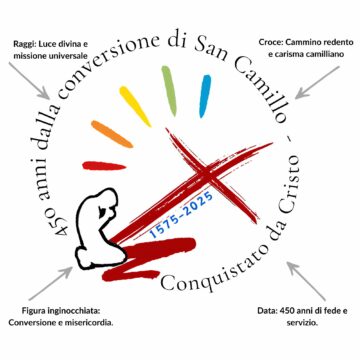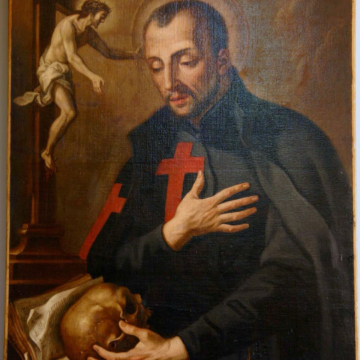 Text taken from Beata Giuseppina Vannini. L’amore dà la vita by Gianfranco Grieco.
Text taken from Beata Giuseppina Vannini. L’amore dà la vita by Gianfranco Grieco.
One need only read Salvifici doloris by John Paul II to understand the prophecy and the contemporary relevance of the message of Mother Giuseppina Vannini.
The founder of the Daughters of St. Camillus, who followed the school of St. Camillus de Lellis, understood more than a century ago how a Christian should approach the world of suffering.
Mother Vannini knew how to respond not only at a personal level to the question of what meaning should be given to suffering – she also sought to provoke in other people a Christian response to the problem of pain.
At the school of Jesus, Mother Vannini teaches us that ‘suffering is defeated by love’. A Christian ‘shares in the sufferings of Christ’. To be a ‘Good Samaritan’ for every man and every woman means embodying and bearing witness to the ‘gospel of suffering’. Every woman and every man who stops at the side of the suffering of another man, of another woman, is a ‘Good Samaritan’, as she, Mother Vannini, herself did.
The Church and society of our time, for some years now, have had a better understanding both of the rights of sick people and the priorities of action and of the message that springs from the human condition of suffering and pain of those who suffer.
John Paul II, who on 1 April 1990 visited the hospital in Acqua Bullicante which is now dedicated to Mother Vannini, was the first to advance this revolutionary proposal. And behind him were the Sons and the Daughters of St. Camillus and the Pontifical Council for Pastoral Assistance to Health Care Workers, with its pioneering president, Cardinal Fiorenzo Angelini, the organiser of days of study and research of an international level that were completely directed towards promoting the rights of sick people and stressing the ‘Christian proposal’ in defence of life at its various stages, from the maternal womb until natural death…
 In a letter sent to Father Angelo Brusco, the Superior General of the Order of the Ministers of the Sick, John Paul II observed how ‘the full recovery and appreciation of this precious inheritance of the Camillian Order also constitutes a particularly important message for contemporary man who is inclined to believe more in witnesses than in teachers, more in experience than in doctrine, and more in life and the facts that in theories. The invitation of St. Camillus to be faithful to the fourth vow, ‘etiam pestis incesserit’ (Gregory XVI, Bull Illius qui pro gregis, 1), sounds out unchanged’, the Pope continued, ‘in our time as well, when new evils, in a different cultural, social and economic context, postulate the same readiness to engage in heroic witness’.
In a letter sent to Father Angelo Brusco, the Superior General of the Order of the Ministers of the Sick, John Paul II observed how ‘the full recovery and appreciation of this precious inheritance of the Camillian Order also constitutes a particularly important message for contemporary man who is inclined to believe more in witnesses than in teachers, more in experience than in doctrine, and more in life and the facts that in theories. The invitation of St. Camillus to be faithful to the fourth vow, ‘etiam pestis incesserit’ (Gregory XVI, Bull Illius qui pro gregis, 1), sounds out unchanged’, the Pope continued, ‘in our time as well, when new evils, in a different cultural, social and economic context, postulate the same readiness to engage in heroic witness’.
‘The dignity and apostolate of those who suffer’. ‘The sick and the infirm in the heart of the Church’. From this ‘catechesis’ begin the provocations of the Pope about the human person, the bearer of values, especially if ‘offended’ and weakened.
‘Jesus himself’, said the Pope in his catechesis on ‘the dignity and the apostolate of those who suffer’, ‘in the proclamation of the Beatitudes considers all the expressions of human suffering: the poor, the hungry, the afflicted, those who are despised by society, or are unjustly persecuted. We, as well, looking at the world, discover so much misery, in a multiplicity of old and new forms: the signs of suffering are everywhere’. ‘The disciples of Christ’, John Paul II continued, ‘have the privilege of understanding the ‘Gospel of suffering’ which has had an at least implicit salvific value in all ages, because ‘Down through the centuries and generations it has been seen that in suffering there is concealed a particular power that draws a person interiorly close to Christ, a special grace’. Those who follow Christ, those who accept the theology of pain of St. Paul, know that suffering is linked to a precious grace, a divine favour, even though it is a grace that remains for us a mystery, because it is concealed under the appearance of a painful destiny’ (General Audience, of 17 April 1994).
Mother Giuseppina Vannini understood more than a century ago the value of this ‘catechesis’. Specifically because of this prophetic insight of hers, the Church on 16 October 1994 raised her to the honour of the altars.
Every day her Daughters strive to embody this ‘history’ in her name.












Camillians on Facebook
Camillians on Twitter
Camillians on Instagram